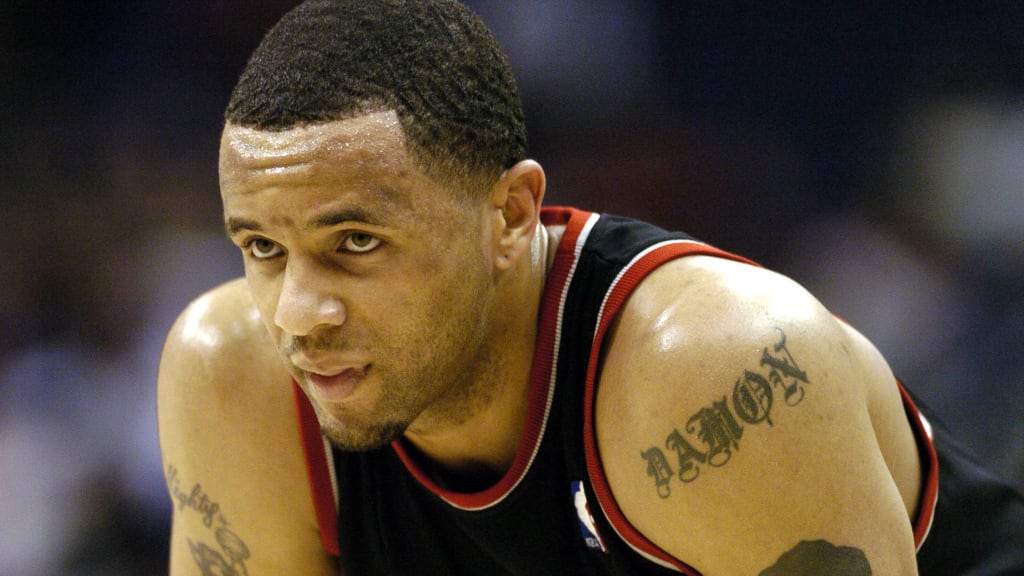On March 5, 2004, a professional basketball player peed into a cup in a gym restroom.
It wasn't because law enforcement or his employer required it. He did it at the request of a Portland newspaper columnist.
The player was Damon Stoudamire, a dynamic point guard whose career had been marred by run-ins with the law.
The columnist? Oregonian scribe John Canzano, who said Stoudamire, a Portland native, had "embarrassed the city" by trying to take marijuana wrapped in aluminum foil through an airport metal detector.
The team's coach, Mo Cheeks, held the restroom door open so Canzano and beat reporter Jason Quick could watch from the hallway.
The idea: to test a Trail Blazers player for cannabis.
Stoudamire's results came back negative for weed, and Canzano declared the experiment a victory. "The Blazers might see their streak of 21 consecutive playoff appearances end this season," he wrote in The Oregonian. "Yet, with this negative test result, and Stoudamire saying he's 'graduated' from his marijuana problems, can anyone call this season a total failure?"
Even by the holier-than-thou standards of American sports columnists, this was a little excessive. Canzano now admits he finds his own behavior a little odd.
"Completely surreal and bizarre!" he tells WW. "Like, I look back and I'm like, is that a business I really want to be in, giving NBA players drug tests? No!"

It looks even stranger 14 years later, in a city with at least a dozen legal, tax revenue-generating pot shops within a 10-minute walk from the Blazers' arena.
Even in 2004, Portland was no stranger to pot, or to athletes smoking it. (Bill Walton did.) Yet the local press ganged up on ganja—and used reefer madness to fuel citywide panic over the "Jail Blazers" era.
Some of the most prominent "scandals" of those five years involved players getting caught with weed: while driving down Interstate 5 on the way home from a Seattle road game (Rasheed Wallace, Stoudamire), while boarding an airplane (Stoudamire again), while handing a cop a trading card as ID (Qyntel Woods).
Even more puzzling: The media conflated pot busts with serious crimes.
Ruben Patterson confessed to an attempted rape of his kids' nanny, broke a man's jaw after he scratched Patterson's car, and committed a "minor assault" on his wife in front of their children.
Players whose only crime was enjoying a little grass were routinely lumped in with the kind of genuine terror that Patterson inflicted on the people in his life.
In a way, the racial divide over marijuana—mostly white, middle-aged men clucking their tongues at young black men—presaged the faux outrage of today's mostly white, middle-aged male shock and horror at the sight of highly paid young black football players expressing their First Amendment rights on their knees.
Most of the relevant players have long ago left Oregon. But the sportswriters who led the public shaming—they're still here.
So I decided to ask them a simple question:
Why did anybody care?

Paranoia around pot arrived long before the town turned on the team. The guy who planted the seeds was longtime Oregonian sports columnist Dwight Jaynes.
Jaynes' columns in the late 1990s helped lay the groundwork for the furor surrounding pot busts.
In a July 17, 1996, column titled "Blazers Face a Questionable Future," Jaynes projected the Blazers' lineups after the team acquired Wallace and an 18-year-old Jermaine O'Neal. "If you want change, this is your team. If you want youth, this is your team. If you want raw talent, this might be your team. But if you own a nightclub in Portland, this most definitely is your team."
After power forward Cliff Robinson got popped for marijuana possession and waving a paintball gun out of a window in downtown Portland in 1997, Jaynes wrote a column tying together Robinson's minor weed infraction with fellow forward Gary Trent punching a guy in a nightclub.
"The fact is, a good portion of professional athletes—especially, it seems, the ones drafted by the Trail Blazers—don't have a real understanding of what it's like to have to obey rules and laws," Jaynes wrote. "They've been treated so specially, by fans, coaches, sportswriters and everyone else, that they don't know what it is to be treated like common citizens.…Just how important is it to you that our basketball team is a winning one? Important enough to compromise moral values? To lower the bar in terms of character of the players?"
Unlike Canzano, Jaynes, now a pundit for NBC Sports Northwest, which broadcasts Blazer games, is unrepentant.
"All the players are very aware of the rules. They get tested several times," he says. "There are still plenty of companies drug-testing employees, and I don't think the NBA is the only one still doing that. You know, if you don't like the rules, you don't have to take the money, you don't have to play."
Jaynes says the blame for the demonization of Blazer smokers isn't on him and his fellow locker-room scribes.
"You have to go back to the time when somebody in town made the decision to label every player on this team as a Jail Blazer. That was probably the most egregious thing done to this group, to put that label on them that lives to this very day. Who did that?"
We-a culpa. It was Willamette Week. On the cover of the Aug. 14, 1996, issue: "JAIL BLAZERS: On the court and in the courtroom: How Portland's NBA team stacks up." The first page of the story reads: "Six current Blazers have run afoul of the law. For details of their criminal activities and an analysis of their value to the team, see chart on page 24."
Nothing about the characterization has aged well. The last two pages of the article are filled with a chart that lines up the same six players that appear on the cover, breaks down whatever malfeasance they were involved in, balances those crimes against their on-court talent, and processes them through a "trouble-over-talent index." It's a bad look.
Jaynes is still heated about that story: "That was a counterculture thing meant to dig at the Blazers!" he says. "That's what that was. So if there was an atmosphere at that time of making these players criminals, it was kicked off by Willamette Week."
Perhaps so. But the sportswriters fanned the flames. Sports talker Colin Cowherd—then at Portland's KFXX 1080 AM—leveraged his scorn toward Blazers into a national platform at ESPN and, later, Fox Sports.
He, too, has no regrets. In 2015, Cowherd wrote a memoir, Raw, in which he described the Jail Blazers as belonging on "every short list for the most reprehensible group of humans who ever shared a locker room."
By 2003, you could open the pages of the New York Post and find the then-dean of NBA moralists, Peter Vecsey, tearing into Wallace by calling him "Rashweed" in print.
"Qyntel Woods was caught grazing in the grass last weekend in Portland," Vecsey wrote on April 2, 2003. "The question is, does practice make prison (term)?"
The momentum kept building with every bust—each columnist trying to whip readers into a greater churn of disgust. It escalated until it somehow made logical sense for a reporter to wait outside a restroom for a urine sample.

Canzano says the drug test was an idea he and Stoudamire reached mutually.
"He said, 'I'll do anything, I'll do anything,'" Canzano recalls. "It was his idea! He said, 'I will take a drug test.' I was like, 'That's different. That's a guy who is willing to put his money where his mouth is.'''
Stoudamire, now head coach of the men's basketball team at the University of the Pacific in Stockton, Calif., did not respond to WW's requests for comment.
But in 2016, he recalled the drug test for the website the Players' Tribune. He described it as a humiliation.
"Listen to me," he wrote in a letter to his younger self. "When the reporter comes to your locker with the empty cup, don't freak out. Don't curse. Don't get offended. Don't even react. This is a very important test for you. Just smile and go pee in the cup."
Canzano says his feelings on the matter have evolved.
"If you're going to choose between being addicted to prescription pain pills or smoking some weed to get through the season," he says, "I'll err on the side of the weed."
Canzano revisited the issue last fall, defending his actions. "As much as attitudes (including my own) about marijuana may have softened with legislation and time," he wrote Oct. 9, 2017, "I don't think the coverage of those teams would have changed much."
"It would still be a deeply disappointing era of Blazers basketball that felt wasted…. And I'd still have appeared at Damon Stoudamire's locker after a practice with a drug-test kit."


